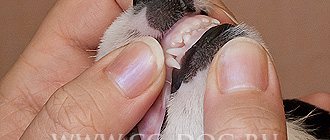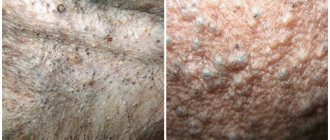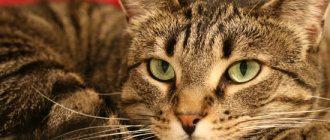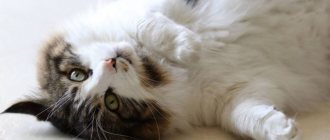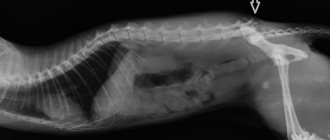The aquarium fish begins to behave strangely, becomes more lethargic, and white dots appear all over the body - these are all signs of a dangerous disease that threatens not only the health of the sick one, but also the rest of the fish in the aquarium. We are talking about a disease such as ichthyophthyriosis or “semolina” . The disease is dangerous, but completely curable if everything is done promptly and correctly. More details about the treatment of ichthyophthyriosis in aquarium fish will be discussed in this article.
Ichthyophthiriasis (semolina) in aquarium fish
What is ichthyophthyriosis
Ichthyophthyriosis is an infectious disease of fish, the development of which is provoked by ciliates. The disease can affect fish of any age and species, so all aquarium pets are at risk. The main symptom of the disease is the formation of light-colored tubercles on the fish, resembling semolina in appearance, which is why the second name of the disease appeared. Having noticed such neoplasms in combination with other abnormalities, treatment for semolina should be started immediately, since the disease will progress every hour and ultimately cause the death of the fish.
Symptoms of ichthyophthyriosis
Due to its small size, the parasite cannot be seen with the naked eye. But during development, ciliates can be identified due to the appearance of small white dots on the body of infected fish. White tubercles are the main sign of ichthyophthyriosis , by which many owners of aquarium fish identify the disease. It is worth noting that the increase in the number of points depends on the degree of infection.
Symptoms of ichthyophthyriosis
There are also secondary signs of semolina that help in diagnosing pathology. The most common ones include:
- decreased appetite up to its complete loss;
- depletion of the infected organism (the activity of the fish is significantly reduced);
- breathing problems due to damage to the gills ;
- the appearance of severe itching (fish begin to intensively rub against foreign objects).
A sick fish's appetite worsens.
Note! The color of the dots that appear plays an important role. If they are not white, but, for example, golden or yellow, then it is likely that this is not ichthyophthyriosis, but velvet disease.
Symptoms and signs of semolina
The main symptom of semolina fish disease is the appearance of grains on the body of phenotypes - at first their number is small, but gradually the number of tubercles increases. Bacteria that cause semolina in fish penetrate into the tank along with contaminated water, food or substrate, and then attach to the scales of aquarium fish. It is important to note that bacteria are able to emerge from the light tubercles on the body of an infected fish, thus infecting all inhabitants of the reservoir. However, aquarists are pleased with the fact that fish that have had ichthyophthyriasis develop immunity to this disease.
Symptoms of semolina in aquarium fish are expressed in the following points:
- Sick individuals are characterized by restless behavior: they rush in different directions, try to scratch themselves on hard surfaces in the tank.
- When organs are damaged, pets lose activity and become apathetic.
- The fish lose their appetite and try to rise to the surface to take a breath of air.
- The body of underwater inhabitants is covered with white spots, which grow, covering the entire body with a white film. With further development, the disease can cause blindness.
If treatment for semolina is not started, the infected individuals will die due to lack of air and damage to the body.
Development of the disease and main symptoms
Semolina is caused by pathogenic microorganisms (ichthyophthirius) that parasitize the skin and gills of fish. Once in the body of an individual, they begin to actively grow, and after 3–5 days they reach a size of 1 mm. This is possible provided that the water temperature in the aquarium is maintained within 24–25 degrees.
When the microorganism has reached an “adult” size, it leaves the fish’s body and settles at the bottom of an artificial reservoir, where it deposits cysts. The division of daughter cells occurs rapidly, within 6–8 hours, and after 2 days the “newborn” parasites begin to look for a donor.
You can recognize a dangerous disease that can affect all types of aquarium fish by the following signs:
- the presence on the body of individuals of small white spots, shaped like particles of semolina. In the early stage of the disease, there are few of them, but gradually the number of affected areas increases.
- change in body color and white coating on the scales. You can often notice that fish affected by the disease have a less bright color than before.
- restless state of individuals. Infected fish tend to rub their bodies against the soil, algae and decorative elements.
- lack of appetite and reaction to external stimuli. These symptoms appear if the disease has affected the internal organs of the fish. And also in these cases, you can observe how the inhabitants of the aquarium float to the surface, greedily swallowing air.
- loss of vision. This occurs when parasites infect the visual organs of the fish.
If one or more symptoms are present, semolina treatment is carried out immediately. Delay can lead to the death of the aquarium inhabitants.
Causes of infection
Treatment of semolina in aquarium fish is complicated by the fact that it is almost impossible to identify the disease in the first stages. It is also important that the disease spreads quickly, so it is necessary to treat ichthyophthyriasis in a community aquarium to avoid re-infection. Scientists have found that most often this disease affects viviparous phenotypes. Semolina is not dangerous for humans.
The main reasons for the appearance of semolina are as follows:
- Feeding contaminated live food.
- Adding sick individuals to the tank with other fish.
- Laying out soil in which pathogens are present.
- No cleaning of the container or replacement of liquid.
- Sudden changes in liquid temperature.
- The presence of conditions that create stress for pets.
Causes of the disease
Ichthyophthyriosis is caused by ciliates that parasitize fish, Ichthyophthirius. White dots on the fins are containers on the tissues in which parasites settle.
Growth on the body of aquarium fish lasts 6-7 days, after which the ciliates leave the body and prepare for reproduction. Having sunk to the bottom, it secretes a cyst, which within a week divides into more than 700 new parasites. Ichthyophthirius swim freely and infect other fish by settling in suitable areas of tissue. As a rule, these are the most vulnerable parts of the fish's body, such as the gills.
Today, the tropical variety of the disease ichthyophthyriosis is widespread. Parasites do not separate from the owner to reproduce, doing this on the body of the fish. These species love high temperatures and are tolerant of different compositions and hardness of water. Treatment is more complex and many traditional methods are ineffective.
Ichthyophthiriasis is a disease of fish whose bodies are weakened by stress. Even a healthy-looking fish can carry a parasite, hiding in its mouth or gills and waiting for the right moment. Therefore, it is quite possible that a new resident, beautiful and healthy in appearance, in a new house will be covered with white dots within a day. Another option is also possible: the newcomer will remain healthy, and the old-timers will be infected. This happens if the fish has already suffered from ichthyophthyriasis and has developed some resistance to the causative agents of the disease. If her treatment was insufficient, she is a carrier of the parasite.
How to cure ichthyophthyriosis
Before treating semolina in a common aquarium, it is important to understand that along with the treatment procedures it is necessary to disinfect the tank itself, otherwise the disease will return again. You should also take action immediately: fish can only be cured if treatment is started in a timely manner, and if no measures are taken, sick pets may die within a week.
Treatment of semolina in fish can be carried out in several ways, each of which deserves detailed consideration.
Salt
Eliminating semolina with salt will be successful if the pathogens entered the aquarium from local waters. Unfortunately, tropical ciliates tolerate salt water very well, so this method is useless for them.
How to treat semolina fish with salt:
- It is necessary to measure the required amount of salt at the rate of 1 tbsp. spoon/10 liters of liquid, and add to the container.
- After this, the temperature is gradually increased to 32C. The course of treatment is 2 weeks.
After completion of treatment for the next month, 30% of the volume must be renewed weekly.
Malachite green
The disease of aquarium fish semolina can be eliminated with the help of malachite green. To get rid of the disease, you need to pour the medicine into the reservoir at the rate of 0.09 mg/1 liter of liquid. After a couple of days, the concentration is reduced to 0.06 mg/1 liter of water, while simultaneously making daily fluid changes in the amount of 25%. The course of treatment is continued until the light tubercles disappear on the body of the patients, and another 2-3 days after their disappearance in order to finally defeat ichthyophthyriosis.
Hydrogen peroxide
Hydrogen peroxide is a miracle cure that is often used to eliminate diseases of aquarium fish. When used, the aquatic environment will be filled with oxygen, which will alleviate the condition of the patients under care. How to get rid of semolina:
- For treatment you will need 3% hydrogen peroxide, with which a healing solution is prepared.
- The product is stirred in water at the rate of 1 ml/10 l of liquid.
When using hydrogen peroxide, you must carefully follow the recommended dose, otherwise you may harm underwater inhabitants.
By other means
Having identified ichthyophthyriosis in fish, you can save your pets and eliminate semolina with furatsilin or other means:
- Antipar is an effective and miraculous remedy based on formaldehyde and brilliant green. For treatment, the drug is used in an amount of 1 ml/50 l of liquid. Duration of use is 5 days. The main disadvantage of the medicine is that it is poorly accepted by fish, and some of the pets may die. Experienced aquarists sometimes make such sacrifices in order to save at least some of the fish.
- Furacilin - the product is available in the form of a yellowish powder. To remove parasites from the aquarium, a solution prepared at the rate of 0.1 g/50 l of liquid is added to the aquatic environment. The course of treatment lasts 2 weeks, after each use the water in the tank should be renewed.
- Branded drugs – in the aquarium hobby there are a lot of professional products, among which Tetra, Sulfur and others are popular. Before using professional products, you must carefully read the instructions and recommendations of the manufacturers.
Description of ichthyophthyriosis
Ichthyophthyriosis is caused by the parasitic ciliated ciliate Ichthyophthirius multifiliis. In the confined space of an aquarium, it is quickly transmitted from one fish to another, thereby causing an epizootic. “Ichtic” appears in the form of convex white dots on the body of the affected fish. The foci of the disease resemble semolina in appearance, for which the disease received its popular name “semolina”.
The white dots on the body of the fish are ichthyophthirius cells (trophosiotes), settled in the pockets of the epithelium and feeding on the skin tissue of the host. The development of the parasite occurs cyclically from 7 to 10 days.
Ichthyophthyrus development cycle:
- After maturation, the trophozoite leaves its shelter and falls into the ground, where it secretes a cyst.
- Within 24 hours, 600-1000 tomites (daughter cells) are formed inside the cyst.
- After growing up, the tomita turns into a theront, which leaves the cyst and goes free swimming, looking for a host among other fish.
Useful tips
Semolina in fish is a dangerous disease that should not be treated with disdain. Regardless of the method chosen, along with treatment, experts recommend adhering to the following instructions:
- Increase aeration in an artificial reservoir.
- Control the required water temperature.
After the treatment of the fish is completed, it is necessary to move all the inhabitants into a separate container, leaving the aquarium empty. In an old aquarium, it is necessary to maintain a temperature of 32C, and install carbon filters to remove any remaining medications. There is no need to remove shellfish and vegetation from the reservoir.
Branded medicines for semolina
A lot has been said about how to treat ichthyophthyriasis in fish, but some previously unknown drugs appear all the time.
Currently, you can find many new medications for semolina with a combined composition. When using them, you need to follow the manufacturer's instructions, but still be vigilant, since some types of fish may be sensitive to certain components, especially formaldehyde. If you are using a drug for the first time, start with a lower dose (for example, 2/3 of the indicated dose). When you are sure that the fish tolerate the product well, you can add the missing amount - usually this is done after 12 hours.
The most effective medications today are:
- Sera Omnisan - suitable for the treatment of mild forms of semolina, that is, for classical treatment.
- The use of Omnisan together with Mikopur is effective in combating tropical ichthyophthyriasis, and if you add ectopur here, the therapeutic effect will increase even more.
- Aquarium Pharmaceuticals (API) capsules cope perfectly with any form of ichthyophthyrriosis. There is also a liquid dosage form of this product, which includes a wound-healing substance - it is used in advanced cases of ichthic, when a significant part of the fish’s skin is damaged. In the first two days, capsules are added to the water, and then, if necessary, they switch to the liquid form of the drug.
- JBL Punktol ULTRA - includes malachite green, crystal violet and methylene blue. They are used to treat severe forms of the disease, while combining them with JBL Ektol crystal.
Prevention
To avoid the development of ichthyophthyriasis in a fish aquarium, each owner must observe the following precautions:
- Quarantine new phenotypes for 2 weeks.
- Clean and clean the tank regularly.
- Monitor the condition of your pets.
- Do not place decorative items or soil that has not been treated in the tank.
When purchasing a new fish, you should carefully examine the individual for the presence of light spots.
It is important to understand that even their absence does not guarantee that the fish is not sick with semolina, so a quarantine container is required.
In addition, it is necessary to constantly monitor the condition of the fish in an artificial reservoir, so that if deviations and symptoms are detected, first aid will be provided to the wards in a timely manner. Decoy can attack underwater inhabitants at any time, but most often infestations occur in spring and summer.
Ichthyophthiriasis in aquarium fish is often underestimated by novice aquarists, not realizing the degree of danger, which leads to the death of pets. Having started an aquarium with colorful fish, it is important to take care of the condition and health of the fish, noticing the signs of an impending decoy in time, and taking related measures for rescue.
UV sterilizer
A modern method of treatment and protection not only from many diseases caused by protozoa. A device that emits UV radiation, which leads to the death of microorganisms.
Power and dosage are selected individually. During illness, most likely, you will simply need to turn it on to constant radiation
.Method 1 (advanced-gentle)
For fish intolerant or intolerant of malachite. We are being treated with delagil. The treatment regimen is as follows: 1 tablet (250 mg) per 30-50 liters of water. After daily water changes of 25-30%, repeated applications are required in an amount equivalent to the changes to restore the concentration of the drug. Can be used with half the dose of malachite green (0.05 mg/l), then the cure occurs faster. If you need to use it without malachite, then it should be noted that the treatment is not quick and at a late stage of infection you may simply not have time to remove the ichthic from the fish. Keeping the temperature elevated and providing aeration is business as usual. Delagil does not damage biofiltration in the indicated doses. There have been cases of damage by delagil to stretching - from simple to fastidious, but this does not occur reproducibly, therefore, apparently, it depends on other factors (for example, pH, gH, etc.). Delagil is not always easy to find in pharmacies.
Method 2 (killer)
It is often recommended to use mixtures of malachite with antibacterial nitrofuran drugs to treat ichthic. Such mixtures often help in the fight against “unkillable” forms of ich due to the fact that nitrofurans not only suppress secondary bacterial infections, but also have a pronounced antiprotozoal (antiparasitic) effect.
This is exactly what SuperIckCure is in capsules - a mixture of malachite green and furacilin (nitrofurazone). Or 'just' a mixture of malachite with furatsilin - for example, the drug 'Malachite green' in the dosage according to the instructions + furatsilin at the rate of 1.5 tablets of 20 mg (this is the usual form of tablets sold in human pharmacies) for every 20 liters of water (which will correspond to the amount of furatsilin in branded drug SuperIckCure - capsules). When treating large fish (in particular red parrots) from tropical ichthic, you can add one and a half dosages of this drug, with the usual dose applied immediately, and the additional 'half' dose gradually.
When using malachite in combination with furazolidone, the latter should be added in the amount of 6-8 tablets of 50 mg per 100 liters of water.
It should be noted that nitrofurans have a detrimental effect on biofiltration, so these mixtures are strongly recommended for use in a leach tank. Or, if this is not possible, then be prepared for a disruption in the biological balance and, accordingly, regular intensive replacements to remove nitrogenous compounds until the normal functioning of biofiltration is established.
Moreover, during the course of these drugs, it is recommended to feed the fish to a minimum (preferably no more than once every 2 days) in order to avoid the accelerated accumulation of nitrogen compounds and poisoning of the fish with them. It is better to carry out replacements daily by 20-25% (or more) of the total volume.
Antipar (Agrovetzaschita) and FMC preparations, which are a mixture of malachite green, methylene blue and formaldehyde, are also not recommended for use in a general aquarium due to expected (due to the presence of methylene blue) biofiltration failures, or when using them, follow the recommendations given in the previous paragraph .
Any treatment and prevention will be more effective in a well-kept aquarium, where the fish are free from stressful situations. The causative agents of the disease ichthyophthyriasis can appear in almost every aquarium. But if its inhabitants are healthy, do not lack nutrients and oxygen, and live in favorable conditions, the disease has little chance of manifesting itself in the aquarium.
GUPPY DISEASES EXTERNAL SIGNS AND TREATMENT PHOTO DESCRIPTION VIDEO.
FIN ROT - DESCRIPTION TREATMENT SYMPTOMS VIDEO PHOTO.
Main reasons
Manka fish disease can attack different types of fish, so therapy must be carried out in the entire aquarium. It has been proven that a pet can get ichthyophthyriasis once in its life. Then immunity is developed.
Viviparous individuals are most prone to the disease. As for humans, this bacterium is not scary for them. The following causes of semolina infection are identified:
- live food that was brought from a tropical area (it is quite difficult to remove ciliates from plants);
- a new resident has appeared in an artificial reservoir;
- contaminated soil;
- poor-quality cleaning of the reservoir (you should regularly remove plaque from the aquarium and clean the filter);
- the appearance of new fish in the aquarium;
- sudden changes in temperature;
- stressful situations for fish.
When the infection occurs at the first stage and there are no white tubercles yet, it is impossible to see it.
"Bicillin-5" - an antibiotic to fight the disease
This is a common human antibiotic of the penicillium group. However, if you are looking for options on how to treat fish for semolina at home, you will probably come across the recipe as a practical recommendation. The dosage when placing fish in a separate container is 500,000 units, that is, a third of a bottle per 10 liters of water. They need to be placed in this solution every day for 30 minutes for 6 days. In addition, the same portion is added to the general aquarium, only for 100 liters of water. This procedure is repeated for 6 days. However, I would like to note that this drug helps fight only a secondary bacterial infection, and not at all the semolina itself. Therefore, do not expect that you will be able to cure your pets this way.
The causative agent of the disease
In order for therapy to be successful, you need to understand very well what caused the development of the disease. In this case, it is caused by an attack by the equiciliate ciliate, a simple organism, which, however, can lead to the complete desolation of your aquarium. That very semolina, which novice aquarists sometimes call dots, specks, bubbles, is the place where parasites are located, pustules from which ciliates come out. At the same time, parasitizing in the body of the fish, they will very quickly lead it to complete exhaustion and death. Therefore, you should know how to treat fish from semolina even before you start the aquarium.
Routes of infection
The parasite has an egg-shaped body and is only one millimeter in size. Ciliates live only two weeks. After the ciliate enters the victim’s body, it becomes saturated within a couple of days. Then, when full, it crawls out through the skin. Its exit looks like a white dot. Having descended to the very bottom of the aquarium, the ciliates begin to multiply. When reproduction is over, she begins to look for the next victim to feed on. Not finding one, the parasite dies of hunger. In one reproduction cycle, ciliates produce thousands of their own kind. Therefore, the problem really exists, and it is not for nothing that people are concerned about the question of how to treat aquarium fish from semolina.
Causes of the disease
Ichthyophthiriasis can be introduced along with live food and soil that was taken from a reservoir into an aquarium and did not undergo a disinfection procedure. The cause of the disease may be recently purchased shellfish, fish or algae that were previously in an aquarium with contaminated water.
The carrier of the disease may be a fish that has been living with you for a long time. Ciliates can live under the epithelium for a long time without manifesting themselves in any way. Under the influence of stress, the body of aquarium fish weakens and cannot fight against infection, which causes increased bacterial activity and becomes the cause of its appearance.
Table salt is the first remedy for ichthyophthirosis
Remember, back in the biology textbooks for the fifth grade, an experiment was described. Two drops of water with a thin isthmus between them, an amoeba was placed in one and salt was added. The amoeba immediately moved to where the water was fresh. That is, salt is harmful to microorganisms. Therefore, we want to tell you how to treat fish from semolina with salt. In fact, the method is good, twenty years ago I was the leading one, there was simply nothing else. The technique is simple: add one tablespoon of salt to 10 liters of water. The fish should survive in this solution for 3 to 5 days. There are methods for making a more concentrated solution, up to 1 tablespoon per liter. The fish are placed in it for 3-5 minutes, and then released into quarantine, where the salt concentration is normal. At this time, the main aquarium is cleaned and disinfected, that is, completely restarted.

